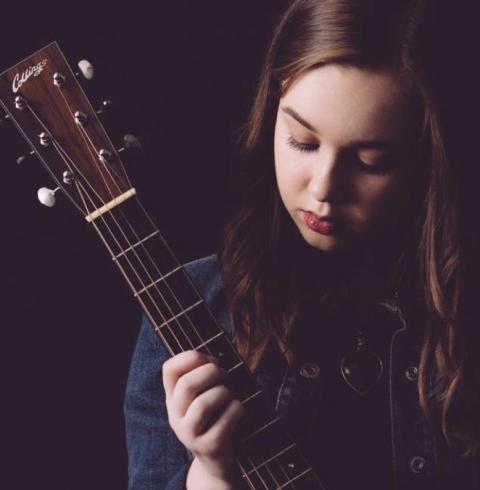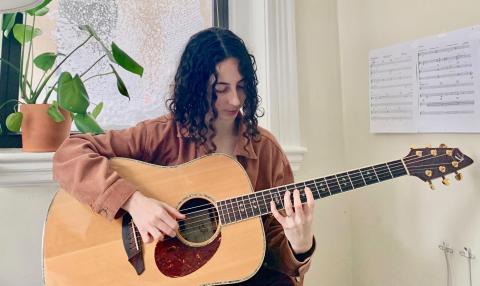Music Magazine Spotlights Student Guitarists Emma Moseley and Maya Locke

Emma Moseley
Image courtesy of the artist
As of last spring, Emma Moseley had taken Bobby Stanton’s class Guitar Artists for every semester she’d been at Berklee. She was considering enrolling in a different lab for her fourth term, last fall, until she heard that fellow guitarist Maya Locke, and Locke’s roommate, Mena Lemos, had signed up for Stanton’s course.
“I was like, ‘I have to take it...it’s two other girls that play fingerstyle. I have to be there. There’s none of us! We don’t exist!” Moseley said, laughing, recalling the many times she’s been the only female guitarist in the room.
The women, plus classmate Min Sung Kim, made such a high-caliber group that last month Fingerstyle Guitar Journal featured Moseley and Locke in its quarterly issue. (Lemos had taken a break from playing due to a broken thumb.)
“I’m excited about it not only because it’s Berklee students, but it’s an opportunity to feature two female musicians,” said Bill Pilburn, the magazine’s publisher. “To be honest, I mean, the guitar world has been kind of dominated by men, and nowadays there are so many accomplished female guitarists.”
Associate Professor Bobby Stanton
Stanton, an associate professor in the Guitar Department, said that while the whole class is impressive, Moseley and Locke stand out.
“I think [Emma] is going to be the next big thing in the guitar world,” he said of Moseley, a traditional fingerstyle guitarist in the style of Tommy Emmanuel.
And Locke, he said, is a musician of extraordinary intelligence who was able to figure out how guitarist Alan Gogoll plays harmonics with both hands, a technique called “bell harmonics.” “Everybody in the world literally has been trying to figure out how this guy did this, and she figured it out,” he said.
YouTube to Berklee
Locke, who’s only been playing guitar for six years, was hesitant to accept credit for deciphering Gogoll’s technique.
“I don’t know that I’m the only one,” she said, adding that she broke down the method by watching a YouTube video on loop for hours and hours. “I realized...when you look at the hand that’s playing harmonics, it moves in a deceptive way.” It was, she told Fingerstyle Guitar Journal, “one of the coolest ideas in guitar performance that I have ever seen.”
Locke’s approach to learning bell harmonics was the same one she used to pick up fingerstyle guitar. Before coming to Berklee, “I didn’t really ever have any fingerstyle training outside of YouTube,” she said. “I would watch YouTubers who post fingerstyle versions of pop songs so you could look up the changes.” Then she’d learn the melody independently, check out the way different people had arranged it, and try to emulate them.

Maya Locke
Now a music education major, Locke first began music instruction at 12, when she took up trumpet for her middle school band in Fort Lauderdale, Florida. Two years later, she moved on to guitar and eventually began lessons (though not in fingerstyle) from an instructor at a local music store. After high school, she spent a year studying music at Florida Atlantic University before coming to Berklee.
Though the first string instrument she played was ukulele, she gravitated toward fingerstyle guitar, drawn to it by its technical nature. “I think there's something about the mechanics of learning fingerstyle, because you really have to slow things down and mechanically work them through,” Locke, who’s now in her fourth semester, said. “There’s something quite nice about that finger and hand isolation, and it all just kind of comes together.”
Her interest in fingerstyle brought her to Stanton, who, she said, was really her first instructor in this style. She had heard about him through Moseley, who was in an arranging class with her. “She was like, “Oh, you’d love this guy Bobby, he teaches this class. We do Chet Atkins and a lot of classic fingerstyle, and it’s really, really cool.”
Austin to Boston
In fact, the opportunity to study with Stanton was one of the main reasons Moseley came to Berklee. “His music and teaching were hugely inspirational for me at the Berklee summer camps I attended growing up,” she told Fingerstyle Guitar Journal of the Five-Week and Guitar Session summer programs she attended before enrolling in Berklee.
Moseley first asked for a guitar when she was 2 years old, but her mother made her wait until she was 6 and could wrap her hand around the neck of the instrument. Within a year, she had her first live gig: at her local library in Gloster, Mississippi, playing at the children’s story hour. That same year she busked in New Orleans.
It was also at 6 years old that she began lessons, studying with up to three different instructors to learn various styles of guitar playing. “Studying all of that classical guitar technique and spending all that time with those professors at a young age kind of gave me the mechanics and the tools,” she said, and laid the foundation for fingerstyle, which she developed an interest in after discovering Tommy Emmanuel on YouTube. “I just looked at it and I said, ‘Oh, this is kind of like the classical guitar stuff but it’s on a steel-string guitar.' And I thought it sounded way cooler.”

Emma Moseley
When Moseley was 14, she and her mother moved to Austin, Texas, so that she could immerse herself more deeply in her guitar studies. One night, she and her mother went to see electric guitarist and local music legend Van Wilks play, and after the show Moseley introduced herself. She happened to have her guitar with her and Wilks asked her to play for him. When she finished, he told her that she was going to play with him the following week. It wasn’t long before Moseley was performing regularly in Austin.
Being in the “live music capital of the world,” she said, “had a huge impact on those teenage years leading up to Berklee...the community here has just been so welcoming and helpful, and really a lot of people have taken me under their wing, allowing me to really infiltrate the performing scene.”
Moseley, who said she’d wanted to attend Berklee since she was 10, is now studying toward a double major in performance and music business on a full scholarship she won at the Lee Ritenour Six String Theory Competition.
Stanton said that he sees in Moseley the kind of promise he saw in Gillian Welch ’92 when she was a student. “I knew she was the next big thing. And so it’s the same with Emma in the fingerstyle,” he said.
Along with Professor Guy Van Duser, who has been Moseley’s private instructor, Stanton has played an important role in developing her as a player. “I feel like no matter how much time I spend with Bobby there’s always something incredibly exciting and new that he has to show me," she said. "He always just seems to know exactly what I really need him to be giving me as a student.”




